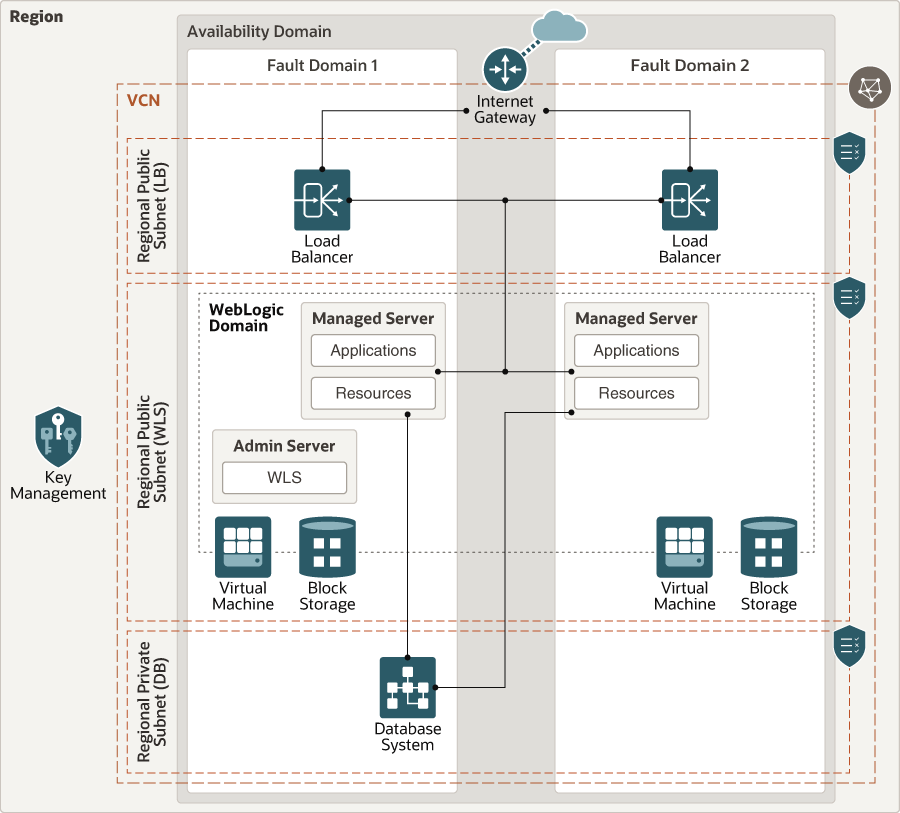Learn About Migrating Your On-premises Oracle WebLogic Server Workloads to the Cloud
Use proven topologies and methods to reduce the effort of moving WebLogic Server workloads to the cloud so you can realize the benefits of using cloud infrastructure.
The WebLogic Server installation presented here covers a number of common migration scenarios.
One set of options migrates on-premises workloads to a newly created domain on Oracle Cloud Infrastructure:
- Manually migrate workloads using the WebLogic Administrator Console to deploy resources and one of the following methods to deploy applications:
- WebLogic Administrator Console
- JDeveloper deployment tools
- Migrate workloads using WebLogic Deploy Tooling (WLDT).
- Migrate workloads using the WebLogic Scripting Tool by targeting existing application deployment scripts to the new domain.
Another option is to update the WebLogic Server tooling that you use to deploy domains on premises (such as WebLogic Scripts, or WebLogic Deploy Tooling model files) and target them to Oracle Cloud Infrastructure to create a new domain and re-deploy applications.
Architecture for Migrating Your Oracle WebLogic Server Workloads to the Cloud
Oracle Cloud Marketplace provides preconfigured stacks to quickly provision a WebLogic Server installation on multiple virtual machines (VMs) and optionally setup a load balancer for the topology.
Oracle WebLogic Server for Oracle Cloud Infrastructure is fully integrated with the underlying infrastructure. This integration makes it easy to provision a WebLogic cluster and provide the required services, such as a load balancer, block volumes, file storage, and the network. The stack creates a default domain configured to run a single managed server per VM for applications.
- WebLogic Server Domain is a compartment concept that includes managed servers on Java virtual machines (JVM) and resources including database connections, libraries, and so on.
- Managed servers are either standalone or organized in clusters, and run on provisioned virtual or bare metal machines.
- Applications are deployed in a domain and assigned a target (managed server or cluster). Similarly, you make application resources available on the associated target.
- Java Required Files (JRF) are optional components included in the WebLogic Server installation that provide common functionality for Oracle business applications and application frameworks. It consists of a number of independently developed libraries and applications that are deployed into a common location including ADF, SOA, and so on.
Before You Begin
Before you migrate your on-premises Oracle WebLogic Server workloads to the cloud, consider the following:
-
Before you upgrade and migrate a database, review the related design solution.
See Learn about reducing downtime during a database migration
-
If you require users who are not administrators to create domains, the Oracle Cloud Infrastructure administrator creates a dynamic group that lists the OCID of the compartment in which users who are not administrators can create domains. The following is a sample dynamic group:
instance.compartment.id='ocid1.compartment.oc1..alongstringofletterandnumbers'The following is a sample of dynamic group policies:Allow dynamic-group MyInstancesGroup to use secret-family in compartment MyCompartment Allow dynamic-group MyInstancesGroup to use keys in compartment MyCompartment Allow dynamic-group MyInstancesGroup to use vaults in compartment MyCompartment Allow dynamic-group MyInstancesGroup to manage instance-family in compartment MyCompartment Allow dynamic-group MyInstancesGroup to manage virtual-network-family in compartment MyCompartment Allow dynamic-group MyInstancesGroup to manage volume-family in compartment MyCompartment Allow dynamic-group MyInstancesGroup to manage load-balancers in compartment MyCompartment Allow dynamic-group MyInstancesGroup to inspect autonomous-transaction-processing-family in compartment MyCompartment Allow dynamic-group MyInstancesGroup to inspect database-family in compartment MyCompartment
About Required Services, Products, and Roles
The following services, products, and roles are required for migrating your Oracle WebLogic Server workloads to the cloud:
This architecture supports the following components:
- Oracle Cloud Infrastructure region: Destination location in the cloud when migrating the database from on-premises.
- Oracle Database: Source databases are on premises and destination databases are provisioned under Oracle Cloud Infrastructure.
- Oracle Autonomous Data Warehouse: Oracle Database in the cloud.
These are the roles needed for each service.
| Service Name: Role | Required to... |
|---|---|
| Oracle Database: root system privileges or sudo with the ability to run commands as root. | Migrate the database. |
Oracle Cloud Infrastructure Identity
and Access Management: OCI_Administrator |
Control policies and who has access to your region's cloud resources. You can control what type of access a group of users have and to which specific resources. |
| Oracle Cloud Infrastructure: Admin |
Manage the transfer of data in Oracle Cloud Infrastructure Block Volumes in the cloud. Optionally, creates a dynamic group that lists the OCID of the compartment in which users who are not administrators can create domains. |
See Learn how to get Oracle Cloud services for Oracle Solutions to get the cloud services you need.
